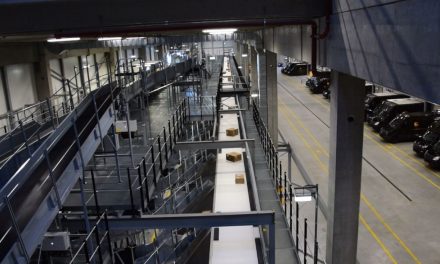
Freight exchanges – Finding their second wind?
They were going to change the world – or so the cynics alleged. Now freight exchanges seem to have found a settled role, and more have survived than you probably think. Peter Rowlands reports
Three years ago, online freight exchanges were going to change the world – and tremors ran through the road transport community. Upstarts from the high-tech world of the dotcoms were going to wade into the traditional haulage market; carriers would have to bid online for work they already had; and the exchanges would take a 5 to 10 per cent commission on every deal. The end was nigh for the cosy old order as we knew it.
Well, nice work if you can get it – that's probably how the surviving freight exchange operators would put it. Most now admit they had a slow and shaky start, and soon had to abandon any wild dreams of massive exchanges and perpetual online auctions. There was no money tree.
What's significant, though, is that quite a number of those early online exchanges are still thriving in one form or another. eLogistics, Freight Traders, Webfreight, X4freight – they're all still around, despite what you might hear from the sceptics. So is Teleroute, which was arguably the original exchange.
What's more, some of them are actually making money. Freight Traders says it achieved break-even last year ("on target," according to managing director Gary Mansell), and X4freight says it moved into profitability at about the same time. Teleroute clearly views the business as one well worth being in, and is currently beefing up its UK presence with a new operational and sales team.
Some exchanges have gone, though. Translinx, promoted with gusto by Just2Clicks, was unceremoniously closed down. TheBackload.com was not respoFinding when we tried its Web site. J2C's freight forwarding transport site, Webfreight, also closed, although it resurfaced last year as a more modest exchange for the courier market.
Yet the casualties are less interesting than what has happened to the surviving exchanges. Basically the people behind them have increasingly adopted a softly-softly approach. You hear much less of the combative term "auction" now (although auctions do still figure in several exchanges), and more about cooperation and mutual benefits. And it actually seems to be working.
Freight Traders is a good example. It quickly moved away from talk of day-to-day freight matching, and says 90 per cent of its business now involves long-term tenders – mostly of a year or more. And the formula seems to have hit the spot. By the end of last year it says it had 172 consignors on its books, and nearly 1,000 carriers; and it claims to have handled freight worth 600 million euros.
Ironically, when Freight Traders launched a spot-market freight matching service last year, it found this unexpectedly successful. "We thought customers would mostly use it for benchmarking," Gary Mansell says, "but some actually use it operationally." However, he says it is unlikely ever to account for a large proportion of the company's business.
Incidentally, although detractors like to point out that Freight Traders is owned by Mars group, and hence has a significant "captive" audience to draw from, Mansell says Mars now accounts for only 8 per cent of its turnover. "The main benefit was that Mars business helped to make the site liquid early on," he says.
Another notable change from the early days of freight exchanges is that most now put much less emphasis on open-market exchanges, and more on their ability to work with closed communities of users who trade with each other. This is central to Freight Traders' approach, and has also become a key to the eLogistics proposition. "Private networks, not public marketplaces, are the way forward," says director Tim Meadows-Smith. Teleroute, too, offers the option of closed groups.
X4freight, however, has stuck with the open market model for its mainly-international exchange. "It's what the market lends itself to," says managing director Bradley Stanton. He says the company is developing the concept of closed user groups in specific vertical markets, but in general he sees more benefits in having a large pool of available freight.
The change in perspective has also brought a change in the way these exchanges are funded. For many, commissions are now a thing of the past. eLogistics, for instance, charges membership fees and flat-rate transaction fees. Teleroute charges a flat monthly fee and a "search" fee (just 17p per item) for calling up details of advertised loads.
Again, however, X4freight operates on a different basis. It usually takes full responsibility for invoicing and settlement, and charges a transaction fee of about 1 per cent. The rate can however be somewhat higher when the company takes on functions such as POD processing and credit risk management.
"In such cases cost is calculated on the basis of when the consignors pay," Stanton says, pointing out that some European consignors can take up to 120 days to settle. "Why should they benefit from the use of another company's balance sheet?"
He admits the X4freight approach "does require a substantial accounting infrastructure," but says it has great appeal for customers – "especially for smaller hauliers who may not have the resources to chase up invoices."
It seems to have worked for the company, which says its substantial predicted turnover of £9.5 million this year will be a mixture of fees and some interfacing charges. However, another contender, MarketTrans, says it is not always an easy sell. Outspoken founder Brian Bolam admits the market has proved "extremely tough". His company, too, handles the financial aspect of transactions, and is in effect the principal in each freight movement. "But it's been difficult to persuade operators to use the system."
Bolam says he remains convinced that the MarketTrans model represents the future for the transport business. "But when will that future come? There are still an awful lot of old-school proprietors of transport companies. Sometimes we get tied up just helping them download their emails." He thinks it could take another two to five years for the market to be converted to using freight exchanges.
"In the meantime, you need to allocate a lot of resource just to debit and credit control," he says, adding: "You lose 5 per cent of costs in working capital management." But MarketTrans takes a resolutely upbeat stance, and is about to spice up its proposition by throwing development efforts into a mobile communications and messaging service. This is due for launch "within a few weeks".
Others have also altered their proposition; indeed, eLogistics now presents itself as a software company, not an exchange. As chief executive Dakshesh Patel puts it: "We specialise in Web-enabled software that facilitates collaboration and transport management solutions." Its main product is called eLogistics Visual Logistics, and aims to harness the Internet to provide a full range of transport execution resources and automate the transport planner's job. Patel says the freight exchange system (now called eLogistics Freight) forms part of this suite, but is by no means the only component.
Something that quickly becomes apparent when you weigh up the UK's online freight exchange market is that it has polarised into separate market segments and trading philosophies, usually with just one or two leaders in each. Freight Traders specialises in long-term tendering, for instance; X4freight concentrates on the continental spot market, and handles payment; MarketTrans covers the domestic spot market, and also handles payment. eLogistics specialises in closed user groups, and also focuses on the domestic market, but doesn't handle payment.
Most of these aim to link shippers with carriers, whereas Teleroute is more of a carrier-to-carrier service, again concentrating on the spot market. It is unusual in covering both the UK and the Continent (where it is much more firmly established), and in this respect it straddles the markets of, say, X4freight and eLogistics.
Teleroute, claiming 37,000 customers Europe-wide and a throughput of 56,000 new job offers a day, towers over the rest of the market, although it is not resting on its laurels. It has just added a new facility called F2 ("F-squared"), under which operators are offered the option of loads involving a deviation from their intended route, and are even given some indication of the cost implications.
It would be misleading to suggest these are the only contenders left in the freight exchange market. Also still thriving, for instance, is the Roadrunner Online Exchange, set up by transport software developer Road Tech Computer Systems. Managing director Derek Beevor says it continues to play a valuable role for hauliers, and can be integrated with its other products, which include management systems, a form of EDI for exchanging data, and vehicle tracking and mobile data. Without fuss, Road Tech is quietly achieving the very connectivity Translinx promoted so vociferously, yet never quite managed to deliver.
Freecargo, another long-established service aimed at hauliers, is also still going strong. It is Dutch-based, but its lively site is available in English, and it takes the unusual line of publishing the names of all subscribers, of which many are British hauliers.
Translogistica, a UK-based site concentrating on long-term tendering, is also still around, although inevitably competing in some respects with Freight Traders. Founder and chief executive Tom Wahnsiedler says it still has a groundswell of support, and reports that it has lately added LTL (less than truckload) haulage and container-based ocean contracts to its original full-load tendering capability. "These are exciting times for us," he says, adding that a major but as-yet confidential project is just approaching completion.
It seems you just can't keep a good idea down.
Who uses them?
One thing you'll often find hard to prise from the freight exchange operators is who their customers are. For some reason, both shippers and carriers seem inexplicably shy about telling the world they use freight exchanges, which in turn are wary of upsetting them. This means public assertions of usage rates are often just that, so you may have to make your own mind up how much volume the exchanges really handle.
Some do, however, reveal a few names. X4Freight's client list, for instance, includes some big international operators like Dachser, Ewals, Goodyear and P&O. Freight Traders' list includes Fabergé, Kellogg's and Lever. And a long-staFinding Teleroute user is Frampton Transport Services, whose international sales manager Gilly Walters comments: "The brilliant thing about Teleroute is the immediacy of the information." Which is after all what it's all about.
Same-day exchanges
Same-day courier-style deliveries lend themselves more readily than almost any other kind of freight movement to a centralised spot-market system based on the Internet. When urgent unpredictable loads come up with virtually no notice, it can be ideal for a carrier to use the Internet to search for a return load (or indeed, for a returning carrier able to take the outgoing load).
Despite the obvious attractions, a single operator, Courier Exchange, seems to have achieved a dominant position in the UK market. Managing director Lyall Cresswell admits it still serves only a cross-section of the entire market; but it is a buoyant, active exchange in which some of the industry's biggest names are said to be involved.
Perhaps one clue to its success is that the company is constantly adding value to its service. For instance, late last year it made provision for subcontracted carriers to be sent order confirmations through the site. More features will follow, including online address books and postcode lookup. Proof of delivery confirmation using mobile communications technology is also being added.
There are other contenders, of course. One is Expeditus, which launched with great gusto two years ago, claiming 700 users. But it has since kept a low profile, and made few apparent changes to its original publicised service for over a year. Webfreight is another; it was acquired from J2C by consultant John Davidson, and relaunched a year ago as a courier-focused business.
Also in the running in this market is MTvan.com, a service which has some elements of an online exchange, and was launched by courier company Speed Services. It is now said to have 70 users, and is likely to be launched soon as "a product as opposed to a data transfer tool," in the words of managing director Martin Rutty.













